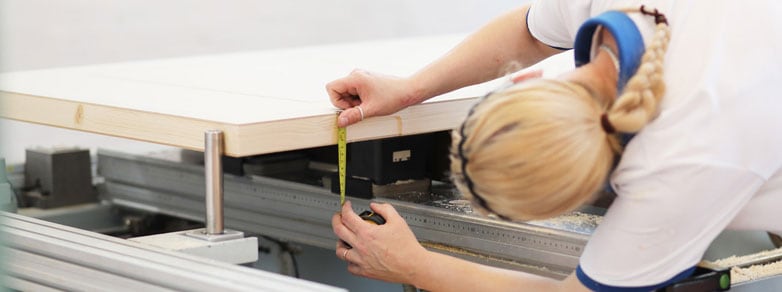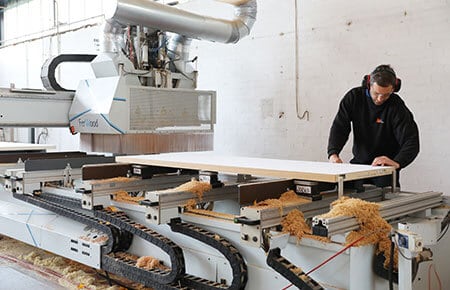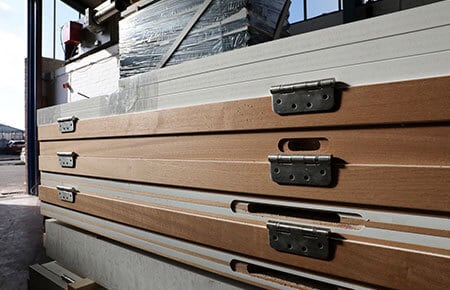At Vigor Doors, we passionately believe that fire doors are made to save lives.
Which is why it is incredibly important that your fire door is not only manufactured well but also installed correctly and maintained over time.
The standard FD30 fire door is made to withstand 30 minutes of fire. But this protection is drastically reduced if they are incorrectly installed or poorly maintained.
People are often so unaware of fire doors, but they are, in fact, everywhere. At work, home, while out shopping and in leisure venues. People pass and use them daily. But some people don’t pay enough attention to their installation or maintenance – and this is where most fire door faults start.
The most common faults found with fire doors are:
Gaps around the door & frame
When installing the fire door, it must be fitted correctly between the frames. This means gaps between the frame and door must be minimal. This is to prevent smoke seeping through spaces during a fire.
The British Woodworking Federation (BWF) recommends that there should only be a maximum of a 3mm gap when the door is closed.
If gaps are larger, more smoke can get through quicker; and they can also affect other safety aspects of the door such as seals and hinges.
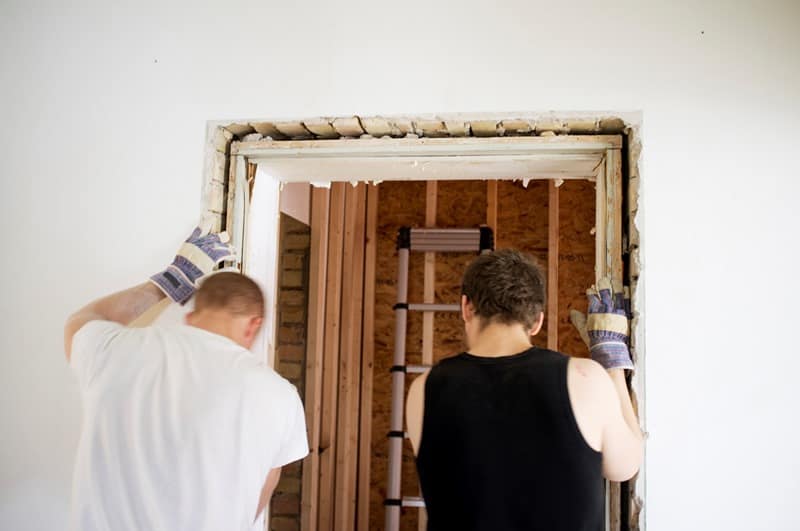
Missing intumescent sealing
Intumescent seals are installed to prevent smoke coming through small gaps around fire doors. These seals expand when in the presence of heat or fire, effectively blocking the spread of smoke between rooms.
It is recommended that all internal fire doors are fitted with intumescent seals. And, yet, the Fire Door Inspection Scheme (FDIS) has found that over 61% of doors inspected were either missing fitted seals or they had been incorrectly fitted.
Also, if the gaps around the door and frame are too large gaps, the intumescent seals may not be able to fill the space, thereby making the solution ineffective.
Intumescent sealing also needs to be used between air grills and around or in glass vision panels. These are custom fire door features that aim to customise your doors, but also play a key part in fire door safety. The key point is where there may be a gap or space that smoke can pass through – and this needs to be sealed.
One thing many people do not realise is that these seals can get damaged over time, with tears often appearing. As soon as the seals are damaged, they are ineffective and must be replaced by a professional.
This damage is often overlooked, unless checked regularly and maintained .
Non fire-rated hinges, panels & letter plates
Although fire doors may be fire rated, often with FD30 or FD60 ratings, this does not mean that all the other fittings – such as hinges, panels and letter plates – are fire rated too.
These parts can make the difference in terms of whether the fire door can withhold up to their maximum fire resistance.
A fire door is expected to have three fire rated hinges to ensure the door is secure to the wall. The need for fire rated hinges is to prevent the warping of hinges during a fire, to withstand the fire/smoke and so they can hold the weight of the fire door.
Similarly, it’s also recommended that letter plates – commonly known as ‘letter boxes’ – fire rated (again, to prevent warping and fire spread).
To increase the effectiveness of letter plates, it is beneficial to use intumescent sealing on the inside and between the door and plate. This prevents smoke spread via the gaps in the letter box.
Panels are often found above the fire door. These can be fire rated glass panels or flush panels. If these are not fire rated, they can easily become smoke damaged and add to the fire. This can counteract the other elements of the fire door that are aiming to slow down and prevent the fire.
Fire rated glass is a better option than ordinary glass, as – when met with fire or high temperature – the glass will crack and fall out. Fire rated glass will leave an intumescent sheet behind rather than shattering or combusting and leaving a hole for smoke to enter through.
Essential Components
These common faults affect some of the most essential components of the fire door and can massively reduce fire door effectiveness.
Intumescent sealing and fire rated materials are extremely important.
- Intumescent seals
These seals, sheets and edging prevent any space or gaps that smoke may enter through, increasing the door’s ability to withstand fire and smoke, and making the fire door a fully sealed blockade.
- Fire rated materials (letter plates, hinges, panels, ironmongery)
Although these may be elements used to customise or install the door, they make a lot of difference in terms of the fire door’s resistance and the length of time it can withstand fire. Using fire rated materials ensures these parts don’t melt, warp, or transfer the fire further.
These elements add to helping the fire door resist fire, heat and smoke, and are essential in providing a barrier between rooms and the fire. Without these essential components, a fire door will not work to its full capacity. And this can be the difference between life or death.
Therefore, it is so important that your fire doors are manufactured to the best quality, installed correctly, have the essential components, and are properly maintained over time.
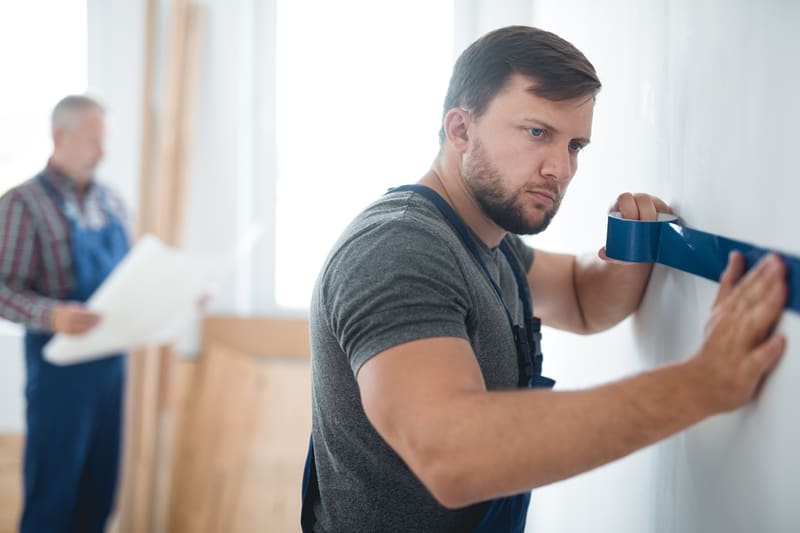
The importance of fire door evaluations
Don’t make the same mistakes. To check your fire doors don’t have any of these faults, organise a fire door evaluation. A professional manufacturer can assess whether your fire doors are appropriately fitted and maintained.
A fire door evaluation generally needs to happen once a year. If you notice any changes or issues with a fire door, these need to be assessed immediately.
It is legally required by Article 17 of the Regulatory Reform (Fire Safety) Order 2005 (RRO/FSO) that “fire resisting doors and escape doors are correctly installed and adequately maintained in order for them to be fit for purpose”. As a building owner or co-ordinator, this is your responsibility. And, if your fire doors don’t not comply with the fire safety order, you can be legally prosecuted and even have your building closed.
After all, these doors are there to prevent, protect and save lives.
An evaluation or fire door inspection should cover any damage or deformation to all fire door elements, including door leaves, ironmongery, frames, signage and seals. The inspector should note any issues and recommend or organise the necessary repairs or replacements. These should be undertaken promptly and with compatible components.
By the way, you can find which components are compatible using your fire certificate data sheet that should have come with your door (if it hasn’t, be sure to check with your fire door manufacturer).
Remember to ensure that your fire door evaluation is conducted by a certified company with the British Woodworking Federation (BWF) mark, such as Vigor Doors.
Maintenance
Just like any other object, fire doors are subjected to wear and tear, and require repairs, replacements and continuous maintenance.
It’s essential to maintain fire doors, especially if they are used frequently, or if any alterations are made or they are located in environments where they could get damaged easily. You need to check they are functioning correctly.
Maintenance and regular inspections can be organised through your fire door contractor, who will usually offer a subscription to their periodic fire door maintenance services. However, there are also training programmes and fire door inspection checklists available online to help organise your own inspections. But we recommend you get the experts in! It’s better to be safe than sorry.
The BWF recommends that – similarly to fire alarms – you test and check your fire doors once every week or month – and that professional checks should be carried out every year. Checking them means you may spot any issues early and be able to prevent future fire door failures.
Maintaining your fire doors is the responsible persons’ or building owner’s duty, according to the official Fire Safety Order. This also makes them responsible for the safety of people accessing and entering that building. By maintaining your fire doors, you are providing essential safety to people using that building.
Top Tips
- Regular fire door evaluation – check, check and double check. Give time to your doors, as they’ll give you time when it matters.
- Get it right the first-time round – use a credible and professional manufacturer and installation company to prevent mistakes.
- Keep an eye on your fire door – after all, they save lives. Look closely at your fire door’s condition, and make sure you’re acutely aware of your emergency exits.
- Plan or schedule your regular maintenance in advance – keep on top of your maintenance.
- Avoid damage to fire doors where possible – do not wedge open or use chains or padlocks on fire doors.
- Research – make sure you research contractors and manufacturers. Don’t undermine the fire door quality for a lower cost.
Avoid these common fire door mistakes and stay safe from fire door failures with Vigor Doors. We offer high quality manufacturing, safe and reliable installation and post-installation quality checks performed by our in-house fire door inspector.
We’re incredibly passionate about getting fire doors right and educating everyone we can on the life-saving importance of fire safety. Our vigorous, rigorous process ensures your fire doors are built for life.
Get your Fire door right the first time. Speak to a member of our Vigor Doors team on 01642 265 034, or drop us a line at info@vigordoors.com – we’re happy to help.
